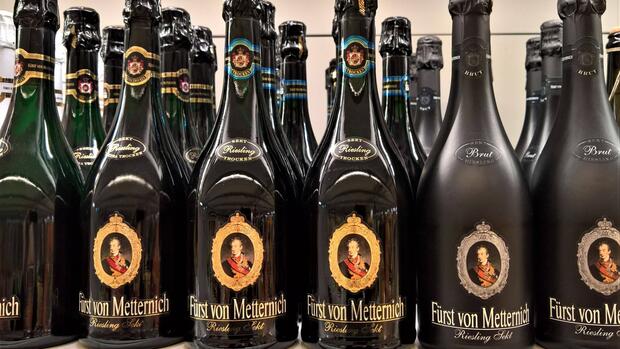Despite good figures, the manufacturer, like the entire industry, had to struggle with some problems in the supply chain.
(Photo: imago images/Manfred Segerer)
Wiesbaden Despite war and inflation, more sparkling wine was drunk around the world in 2022. Spanish cava was particularly in demand. Henkell-Freixenet, the world’s largest sparkling wine producer, also benefited from this trend.
Since joining the Spanish cava producer Freixenet five years ago, the Wiesbaden sparkling wine producer has risen to become the largest sparkling wine producer in the world. “Freixenet is the best-selling sparkling wine brand ever,” said Andreas Brokemper, CEO of Henkell Freixenet on Wednesday when the annual figures were presented.
In 2022, the company set a new sales record of EUR 1.18 billion – after deducting sparkling wine and spirits tax. This is an increase of 8.5 percent compared to the previous year. Growth drivers were premium brands and business in America. Sales there increased by almost 30 percent to 216 million euros and overtook those in Eastern Europe for the first time.
Oetker split off the champagne business from pizza and beer
“Especially since the takeover of Freixenet, Henkell is very well prepared for the market. The international sales channels have complemented each other,” states industry expert Clemens Gerke, editor-in-chief of the specialist magazine “Weinwirtschaft”. In the inflation year 2022, the Wiesbaden-based company was able to further expand its leading position on the world market. The market share is now 9.5 percent, as determined by the market researcher IWSR.
“Our growth is not only based on price increases and more favorable exchange rates, our sales have also increased,” Brokemper clarifies. The family business with 3,650 employees traditionally does not comment on profits.
The sparkling wine, wine and spirits company is the largest company of the Geschwister Oetker Beteiligungen KG. In November, the three youngest Oetker siblings split from the parent company in Bielefeld after years of quarreling. Pudding, pizza, cakes and beer still belong to the five older half-siblings.
Despite good figures, Henkell Freixenet, like the entire industry, had to contend with some problems in the supply chain. “Since the end of 2021, production costs have risen massively. The cost drivers here are in particular the prices for glass bottles,” says industry expert Gerke. Brokemper explains that container glass has become very scarce and extremely expensive because two important glass plants in the Ukraine failed.
Basic wine has also become expensive and scarce in some cases. The cause is climate change: Night frosts in France and extreme drought in Spain have greatly reduced the grape harvest there. Transport costs and freight rates also went up significantly. However, according to Gerke, it is difficult for the industry to pass on the increased prices to retailers and consumers.
Long price war with Kaufland leaves its mark
Henkell Freixenet did not find understanding for price increases among all retailers. There was a heated argument with the supermarket chain Kaufland, which belongs to the Schwarz Group, about new prices for the Fürst von Metternich sparkling wine brand. “We interrupted the delivery and accepted losses in sales,” says Brokemper. Henkell’s business in German-speaking countries grew at a below-average rate of 3.4 percent to 318 million euros. In the meantime there has been a price agreement with Kaufland.
The head of Henkell Freixenet fought hard for price increases.
The price increases for sparkling wine varied greatly depending on the category. According to Brokemper, they were the greatest at 20 to 30 percent for Prosecco. Here the run on rosé led to a shortage on the market. But consumers can still shop cheaply. Because up to 70 percent of sparkling wine in Germany is sold through discount campaigns. “With our Prosecco brand Mionetto, the proportion is well below 30 percent,” emphasizes Brokemper.
“Amazingly, the sparkling wine industry came through the inflation better overall than the still wine industry,” concludes expert Gerke. The consumption of sparkling wine remained stable in 2022 – every German drank an average of 3.2 liters.
>> Read also: Schloss Wachenheim: Profit of three cents per bottle – why cheaper sparkling wine now has to become more expensive
The market leader in Germany is not Henkell, but competitor Rotkummel-Mumm. Their company boss Christof Queisser recently drew a mixed balance for 2022. Sales remained stable at 1.24 billion euros (including sparkling wine and alcohol taxes). Even Little Red Riding Hood was only able to pass on part of the sharply increased costs to retailers. Queisser got consumers in the mood for a “new, sustainably higher price level”.
Meanwhile, Henkell boss Brokemper is cautiously optimistic about the current year: “Our growth will not be as strong as in previous years.” He sees huge potential for sparkling wine without alcohol: “Here we are already the leading manufacturer in the world.”
More: Sparkling wine as an economic barometer – inflation characterizes the business of the wineries

